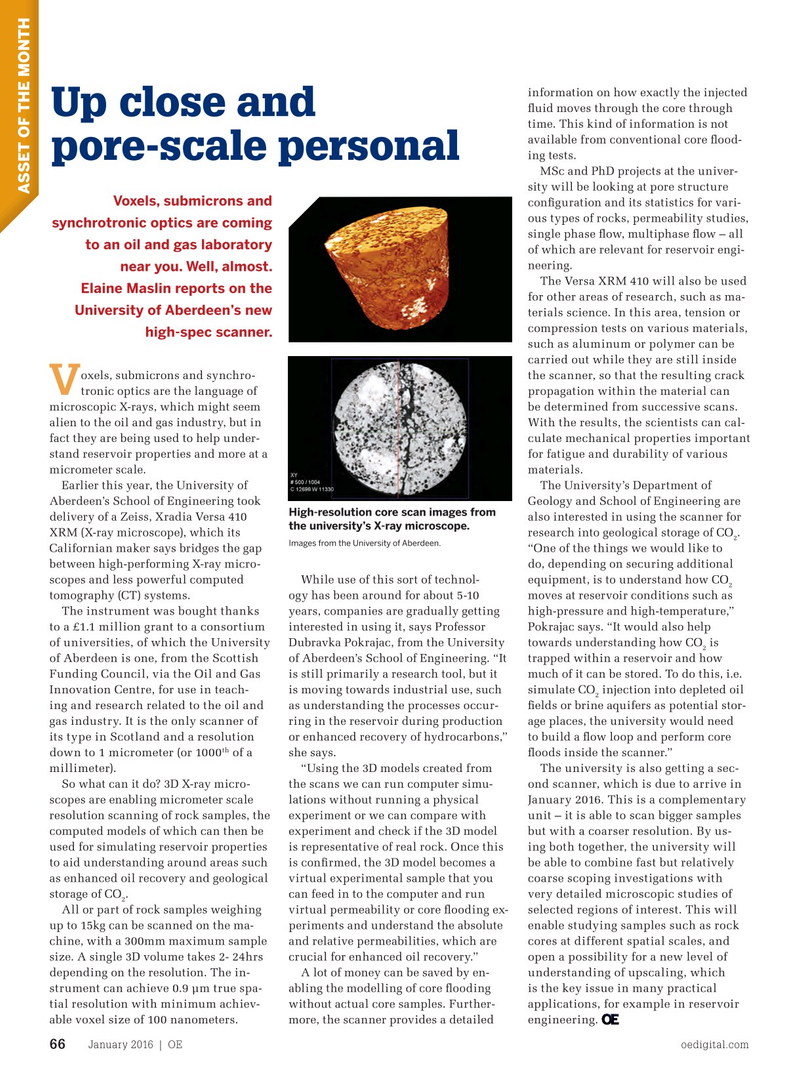
Page 64: of Offshore Engineer Magazine (Jan/Feb 2016)
Read this page in Pdf, Flash or Html5 edition of Jan/Feb 2016 Offshore Engineer Magazine
information on how exactly the injected ? uid moves through the core through
Up close and time. This kind of information is not available from conventional core ? ood- ing tests. pore-scale personal
MSc and PhD projects at the univer- sity will be looking at pore structure
ASSET OF THE MONTH
Voxels, submicrons and con? guration and its statistics for vari- ous types of rocks, permeability studies, synchrotronic optics are coming single phase ? ow, multiphase ? ow – all to an oil and gas laboratory of which are relevant for reservoir engi- neering. near you. Well, almost.
The Versa XRM 410 will also be used
Elaine Maslin reports on the for other areas of research, such as ma-
University of Aberdeen’s new terials science. In this area, tension or compression tests on various materials, high-spec scanner.
such as aluminum or polymer can be carried out while they are still inside oxels, submicrons and synchro- the scanner, so that the resulting crack
V tronic optics are the language of propagation within the material can microscopic X-rays, which might seem be determined from successive scans. alien to the oil and gas industry, but in With the results, the scientists can cal- fact they are being used to help under- culate mechanical properties important stand reservoir properties and more at a for fatigue and durability of various micrometer scale. materials.
Earlier this year, the University of The University’s Department of
Aberdeen’s School of Engineering took Geology and School of Engineering are
High-resolution core scan images from delivery of a Zeiss, Xradia Versa 410 also interested in using the scanner for the university’s X-ray microscope.
XRM (X-ray microscope), which its research into geological storage of CO . 2
Images from the University of Aberdeen.
Californian maker says bridges the gap “One of the things we would like to between high-performing X-ray micro- do, depending on securing additional scopes and less powerful computed While use of this sort of technol- equipment, is to understand how CO 2 tomography (CT) systems. ogy has been around for about 5-10 moves at reservoir conditions such as
The instrument was bought thanks years, companies are gradually getting high-pressure and high-temperature,” to a £1.1 million grant to a consortium interested in using it, says Professor Pokrajac says. “It would also help of universities, of which the University
Dubravka Pokrajac, from the University towards understanding how CO is 2 of Aberdeen is one, from the Scottish of Aberdeen’s

 63
63

 3rd Cover
3rd Cover